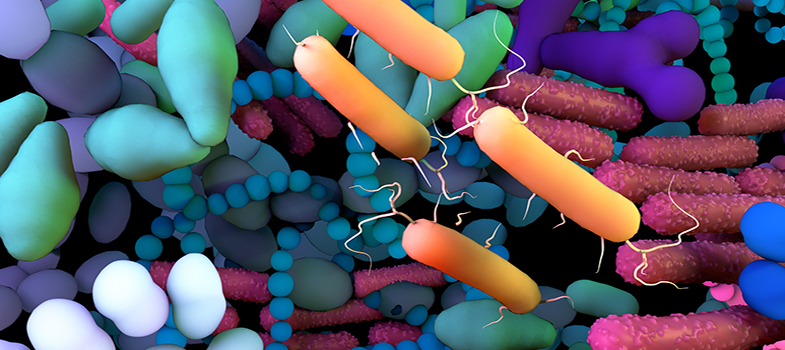Glossary
Special | A | B | C | D | E | F | G | H | I | J | K | L | M | N | O | P | Q | R | S | T | U | V | W | X | Y | Z | ALL
A |
|---|
acquired resistanceResistance to an antibiotic to which a bacterium is innately susceptible. It occurs when a bacterium acquires the ability to resist the actions of a particular antibiotic through either genetic mutation or horizontal gene transfer. | |
antibacterialA compound (drug) that specifically kills or inhibits the growth of bacteria. | |
antibioticFormally, a compound that is produced by or derived from a microorganism and that can be effectively used to kill or inhibit the growth of other microorganisms. The term is commonly used also for synthetic antimicrobial compounds; in this course, it is used as a synonym for 'antibacterial'. | |
antifungalA compound (drug) that specifically kills or inhibits the growth of pathogenic fungi. | |
antimicrobialA compound (drug) that kills or inhibits the growth of any type of pathogenic microorganism: bacteria, fungi, parasites or viruses. | |
antimicrobial resistance (AMR)Resistance that is acquired by or innate to a microbe (most often, a bacterium) to any compound that is designed to kill it or inhibit its growth. | |
antiparasiticA compound (drug) that specifically kills or inhibits the growth of one or more parasitic organisms. | |
antiviralA compound that specifically kills a virus, or prevents the spread of a viral infection. | |
B |
|---|
broad-spectrum antibioticsAntibiotics that affect (either kill, or stop reproducing) a wide range of bacteria: particularly, both Gram-positive and Gram-negative species. | |
E |
|---|
epidemiologyThe science of the incidence, distribution and control of disease: here, particularly, infectious disease. | |
F |
|---|
G |
|---|
genetic mutationsChanges in the sequence of DNA due to either errors made while copying the DNA or environmental factors. Genetic mutations in genes can result in changes to the amino acid sequence encoded by the gene and may change the function of the resulting protein. | |
germ theoryThe theory that many diseases are caused by microorganisms (originally termed ‘germs’). | |
GLASSThe Global Antimicrobial Resistance Surveillance System for standardising and sharing surveillance data on antimicrobial resistance (AMR) worldwide. | |
Global Action Plan (GAP)A plan for tackling antimicrobial resistance (AMR) worldwide endorsed at the World Health Assembly in 2015, with five strategic objectives. | |
H |
|---|
hostAn organism that is colonised by a microorganism – generally, but not necessarily, a pathogenic microorganism. | |
I |
|---|
infectious diseasesDiseases that are caused by pathogenic microorganisms that can be directly or indirectly transmitted from one host to another. | |
innate resistance(Also known as ‘intrinsic resistance’.) The innate ability of a bacterial species to resist the action of antibiotic as a consequence of the bacteria’s structural or functional characteristics. | |
M |
|---|
MRSA(Full name: methicillin-resistant Staphylococcus aureus.) Strains of the pathogenic bacterium Staphylococcus aureus that are resistant to the antibiotic methicillin and cause diseases ranging from simple but difficult-to-treat skin infections to life-threatening septic shock. | |
multi-drug-resistantBacteria (or, infrequently, other microorganisms) that are resistant to a range of different antibiotics. | |
N |
|---|
narrow-spectrum antibioticsAntibiotics that only affect a small range of bacterial types. | |
O |
|---|
One HealthA collaborative approach to healthcare and health research that recognises the interconnection between humans, animals, plants and their shared environment. | |
opportunistic pathogensMicroorganisms that are normally commensal and do not harm their host but can become pathogenic and cause infection when the host’s immune defences are compromised. | |
P |
|---|
pathogenAn organism – generally, but not necessarily, a microorganism – that is responsible for causing disease: that is to say, an organism that is pathogenic. | |
pathogenicCapable of causing disease. | |
penicillinsA group of antibiotics based on compounds originally discovered in common moulds that inhibit the formation of the bacterial cell wall. | |
prevalenceThe proportion of a population that is suffering from a particular disease at a particular time. | |
S |
|---|
selective toxicityThe targeting of drugs to affect only the disease-causing, pathogenic organism and minimise damage to the host cells and commensal mico-organisms. | |
septic shockA serious and potentially fatal condition that arises after an infection has become systemic. It is characterised by severe low blood pressure (hypotension). | |
surgical prophylaxisTreating patients with antibiotics prior to surgery to prevent them from developing infections afterwards. | |
T |
|---|
tripartite collaborationA collaboration between three intergovernmental organisations (the FAO, OIE and WHO) to work holistically together to minimise the spread of and risk of antimicrobial resistance (AMR). | |
V |
|---|
virusAn infectious agent that is approximately ten times smaller than a bacterium and cannot replicate outside a host cell. Viral infections cannot be treated with antibiotics. | |
W |
|---|
World Health Assembly (WHA)The decision-making body of the World Health Organization (WHO), which meets once a year and is attended by all member states. | |
World Organisation for Animal Health (OIE)The intergovernmental organisation responsible for improving the health of livestock and other animals worldwide. (The acronym is derived from the original French name of the organisation, Office International des Epizooties.) | |
Z |
|---|
zoonotic diseaseA disease that usually exists in animals but can be transmitted from animals to humans. | |
For further information, take a look at our frequently asked questions which may give you the support you need.
If you have any concerns about anything on this site please get in contact with us here.



